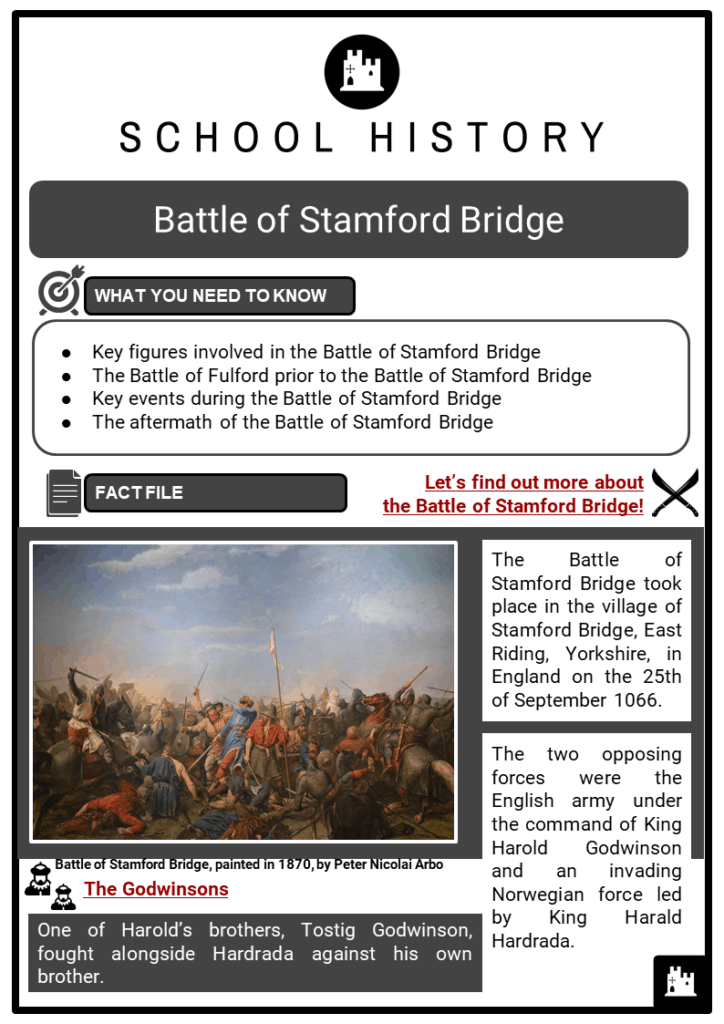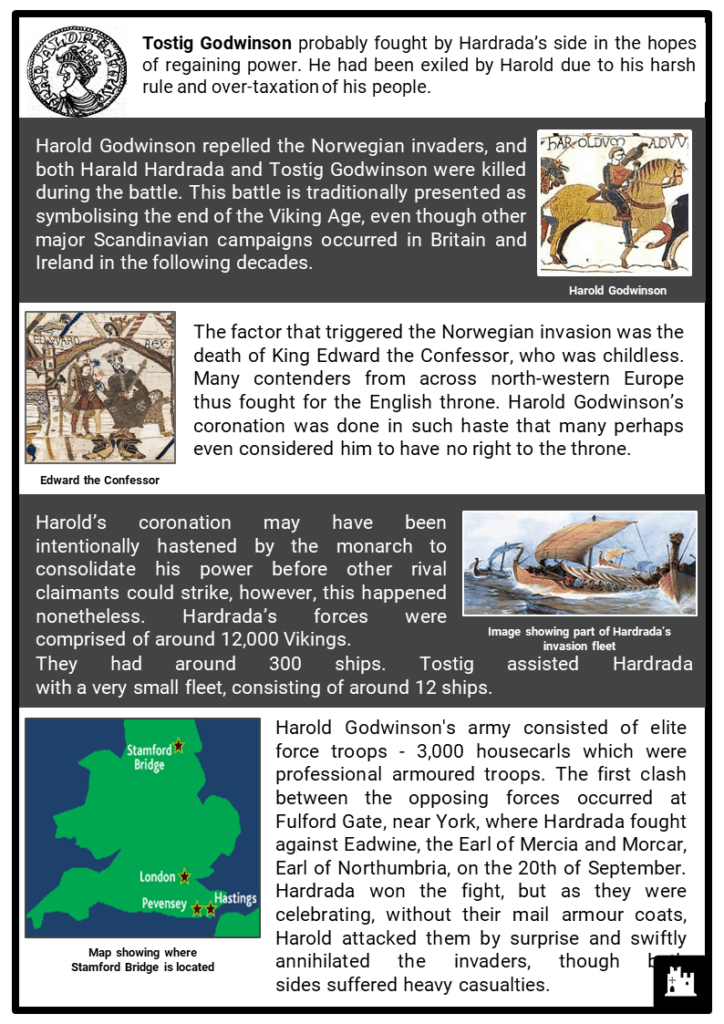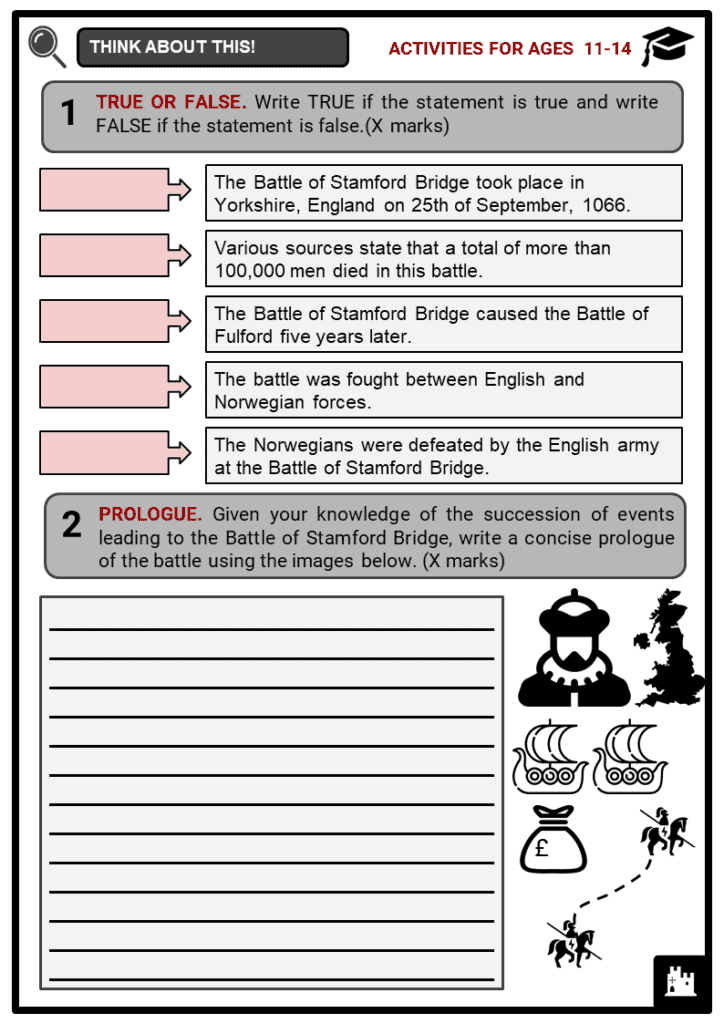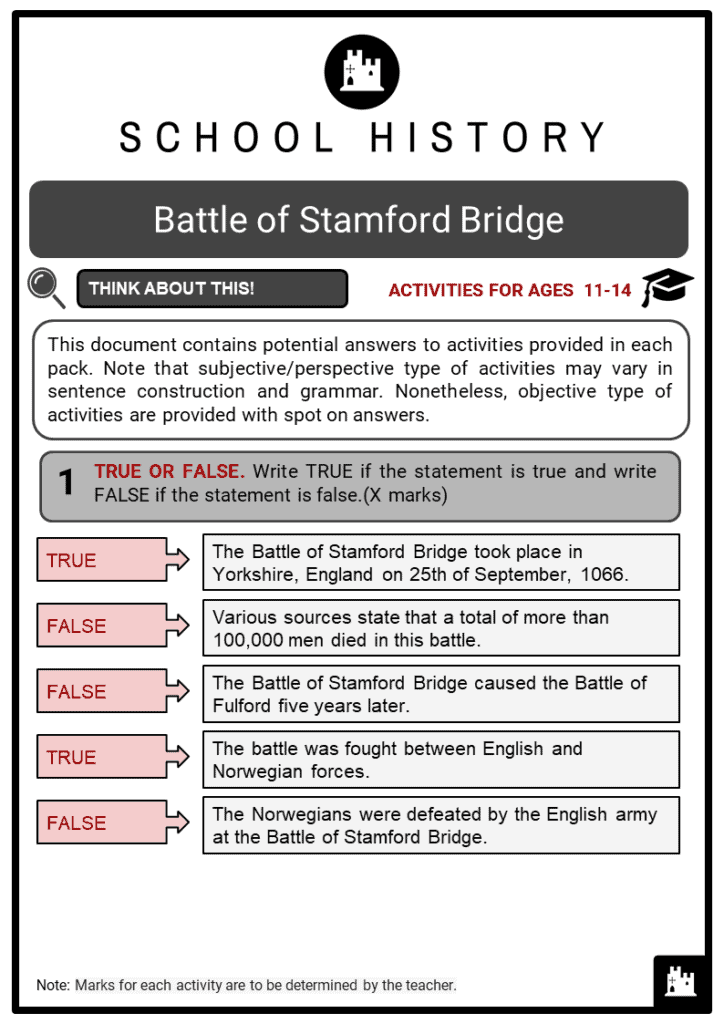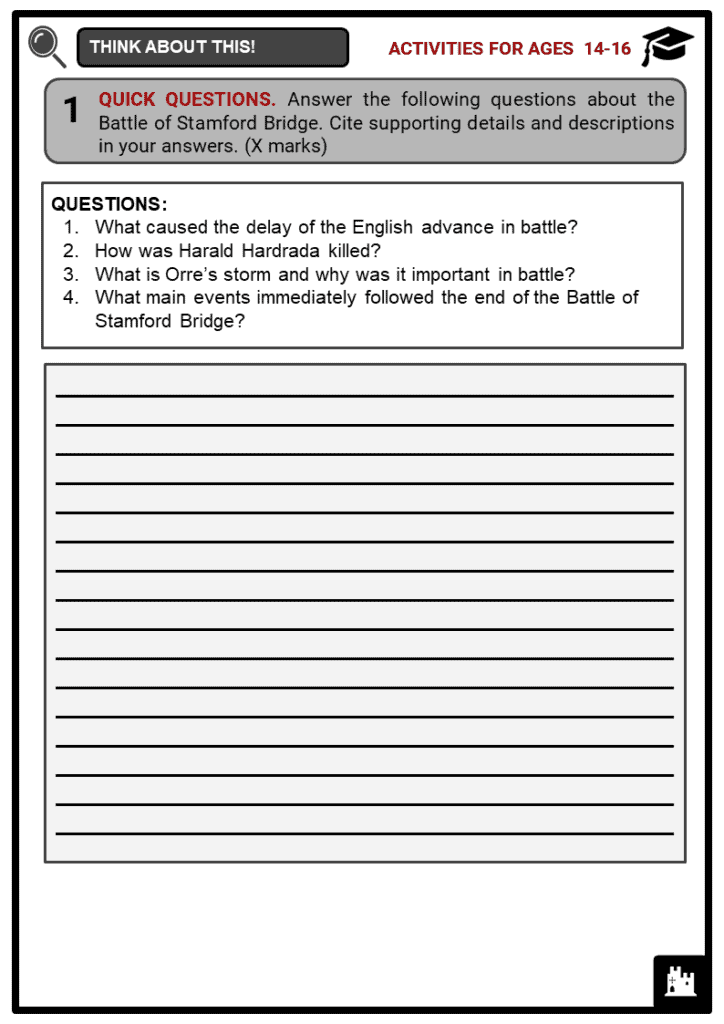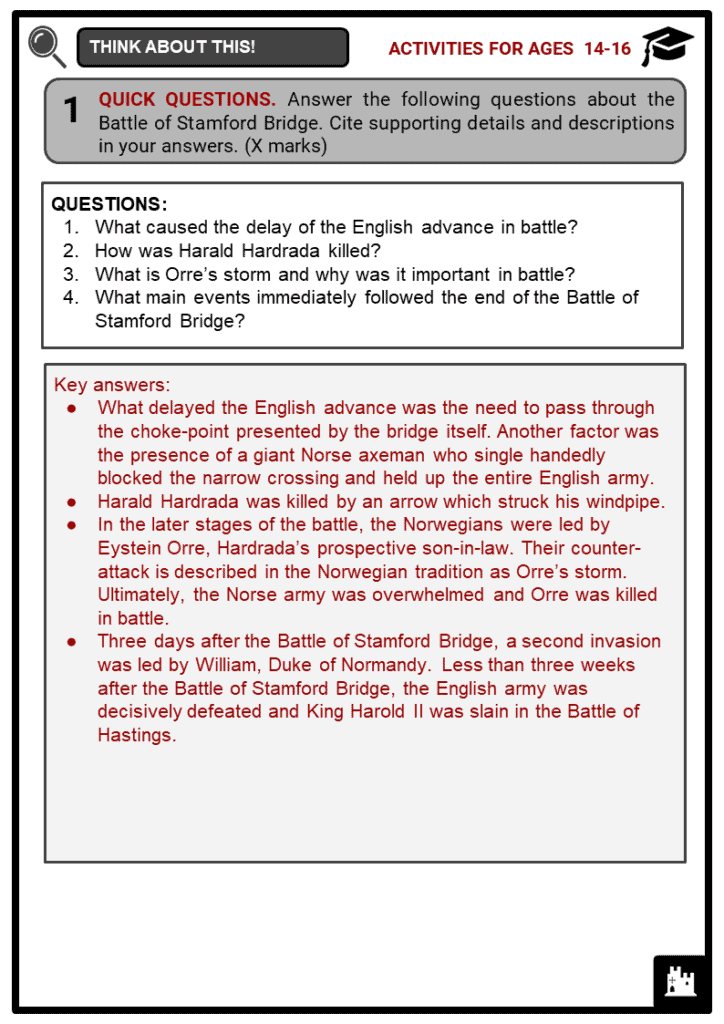Download Battle of Stamford Bridge Worksheets
Do you want to save dozens of hours in time? Get your evenings and weekends back? Be able to teach Battle of Stamford Bridge to your students?
Our worksheet bundle includes a fact file and printable worksheets and student activities. Perfect for both the classroom and homeschooling!
Table of Contents
Add a header to begin generating the table of contents
Summary
- Key figures involved in the Battle of Stamford Bridge
- The Battle of Fulford prior to the Battle of Stamford Bridge
- Key events during the Battle of Stamford Bridge
- The aftermath of the Battle of Stamford Bridge
Key Facts And Information
Let’s find out more about the Battle of Stamford Bridge!
- The Battle of Stamford Bridge took place in the village of Stamford Bridge, East Riding, Yorkshire, in England on the 25th of September 1066.
- The two opposing forces were the English army under the command of King Harold Godwinson and an invading Norwegian force led by King Harald Hardrada.
The Godwinsons
- One of Harold’s brothers, Tostig Godwinson, fought alongside Hardrada against his own brother.
Prologue
- In January 1066, the then king of England, Edward the Confessor had died. This triggered a succession struggle in which a variety of contenders from across north-western Europe fought for the English throne. One of these claimants included the King of Norway, Harald Hardrada.
- According to the Anglo-Saxon Chronicle, the Norwegians assembled a fleet of 300 ships to invade England.
- The authors, however, couldn’t differentiate between warships and supply ships. The army had nonetheless around 7,000 to 12,000 men, which included the forces recruited in Flanders and Scotland by Tostig Godwinson. Tostig was at odds with his elder brother, Harold Godwinson, having been ousted from his position as Earl of Northumbria and exiled.
- Tostig’s harsh rule and over-taxation had caused a serious revolt in Northumbria in 1065.
- Harold managed to placate the Northumbrian nobility by visiting the area in person. Some rumours claimed that Harold actually engineered the whole scenario to gain greater favour with King Edward and promote himself as the king's chosen heir.
Battle of Fulford
- On the 20th of September, Hardrada and Tostig’s forces defeated a northern English army led by Eadwine, the Earl of Mercia, and his brother Morcar, the Earl of Northumbria, at the Battle of Fulford, outside York.
- Following this victory, they received the surrender of York. As the invading forces occupied the city, they had taken many hostages and supplies and returned towards their ships at Riccall.
- They offered peace to the Northumbrians but only if they supported Hardrada’s bid for the throne. They also demanded further hostages from the whole of Yorkshire.
- When all of this happened, King Harold was in southern England, anticipating an invasion from France by William, Duke of Normandy, another contender for the English throne. When he learned of the Norwegian invasion he headed north in great haste with his huscarls and as many thegns as he could gather, travelling day and night.
- Harold made the journey from London to Yorkshire, a distance of around 185 miles / 298 kilometres, in only four days. This enabled him to take the Norwegians completely by surprise.
- When Harold heard of the additional hostages and supplies demanded by the invaders at Stamford Bridge, he hurried on through York to attack them at this rendezvous on the 25th of September. Until the English army came into view, the Norwegians remained completely unaware of the presence of a hostile army anywhere in the vicinity.
Location
- There is some controversy over whether or not a village and bridge existed at the time of the battle.
- One theory states that there was no village at Stamford Bridge in 1066 and not even in 1086 when the Domesday Book was written.
- However, some of the Anglo-Saxon Chronicle manuscripts mention Stamford Bridge by name and describe part of the battle being fought across the bridge, therefore, a bridge over the Derwent river most likely did exist at the time.
- The exact location of the Stamford Bridge battlefield is not known. Local tradition places the battlefield east of the River Derwent and just southeast of the town in an area known as Battle Flats.
- The location of the Norwegian army at the start of the battle is not known for certain. Accounts differ regarding their location.
- A common view is that the Norwegian army was divided in two, some of them were on the west side of the River Derwent, and the bulk of the army was stationed on the east side.
Battle of Stamford Bridge
- According to Snorri Sturluson, an Icelandic historian, before the battle began, a man rode up alone to Harald Hardrada and Tostig.
- One thing is certain, the appearance of the English army caught the Norwegians by surprise, as they weren’t prepared for a battle so soon after their victory at Fulford Gate, near York.
- They were probably celebrating their victory, and most of them didn’t have their mail armour coats on, when Harold and his army attacked them.
- If they were located on the east side of the Derwent, the deployment made perfect sense since, by the time the bulk of Harold’s forces had arrived, the Vikings on the west side were either slain or had fled across the bridge.
- What delayed the English advance was the need to pass through the choke-point presented by the bridge itself.
- Another factor was the presence of a giant Norse axeman who single handedly blocked the narrow crossing and held up the entire English army.
- Harold’s army travelled from London to York, a distance of 185 miles, in just 4 days.
- The story states that this axeman cut down up to 40 Englishmen and was only defeated by a soldier who floated under the bridge in a half-barrel and thrust his spear through the planks in the bridge, mortally wounding the great warrior.
- Regardless, this delay helped the Norse army as they were able to form a shieldwall to face the English attack.
- Harold’s army poured across the bridge and the battle went far beyond the bridge itself.
- Though the battle waged for hours, the Norwegians were at a great disadvantage as they left their armoury behind.
- The Norse army gradually became fragmented and fractured, allowing the English troops to force their way in and break up the shield wall.
The fall of Hardrada and Tostig
- They were completely outflanked, and their leader, Hardrada, was killed by an arrow which struck his windpipe.
- Soon, Tostig himself was slain, and the Norwegian army disintegrated, being almost completely wiped out.
- In the later stages of the battle, the Norwegians were reinforced by troops who had been guarding their ships at Riccall.
- They were led by Eystein Orre, Hardrada’s prospective son-in-law. Some of his men died due to exhaustion when they reached the battlefield, while the remainder were fully armed for battle.
- Some accounts state that a total of over 10,000 men died in this battle.
- Their counter-attack is described in the Norwegian tradition as Orre’s storm, as they briefly checked the English advance, however, they were ultimately overwhelmed and Orre himself was slain.
- Some of the fleeing Norsemen drowned while crossing the rivers. Many died on both sides, and since they died in a small area, the field was said to have been whitened with bleached bones 50 years after the battle.
Aftermath
- King Harold accepted a truce with the surviving Norwegians, including Hardrada’s son, Olaf, and Paul Thorfinnsson, Earl of Orkney.
- After they pledged not to attack England again, they were allowed to leave.
- The Norwegian army suffered such losses that only 24 ships from the fleet of 300 were needed to carry the survivors away. Harold’s victory was short-lived, however.
- Three days after the Battle of Stamford Bridge, on the 28th of September, a second invasion army led by William, Duke of Normandy, landed in Pevensey Bay, Sussex, on the south coast of England.
- Harold turned his troops around and marched swiftly southwards to intercept the Norman army. Less than three weeks after the Battle of Stamford Bridge, on the 14th of October 1066, the English army was decisively defeated and King Harold II was slain in the Battle of Hastings.
- The results may have been different if the English army wasn’t tired from the long march and the battle with the Viking army. Regardless, this defeat marked the beginning of the Norman conquest of England.
- There are two monuments dedicated to this battle in and around the village of Stamford Bridge.

